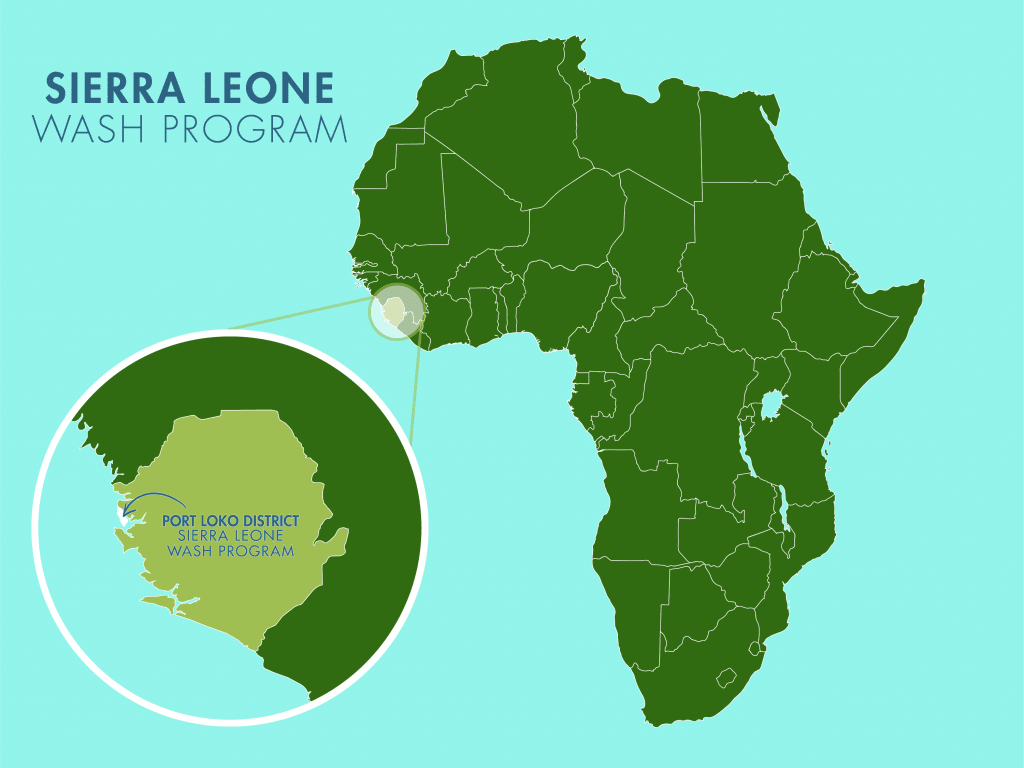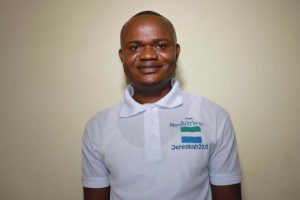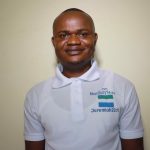Seventeen-year-old Adama lives in Malai Bundu with 148 residents, a growing community along the Port Loko Highway in Lungi. Every day, she faces the same exhausting challenge—fetching water for her family. What should be a simple task takes her nearly four hours each day.

Adama (front) leads the way on the hunt for water.
“Fetching water, especially during the dry season, is a task for me,” Adama explains. “I spend time fetching water from the well when there is no water in the well, or the pump is not working. The well is now dry, so I have to fetch water from the swamp. I spend more time getting water from the swamp since it is a distant, hilly path, and the process of collecting water is difficult. It is again difficult for me to cross the Port Loko highway and railway in search of water. The swamp water point is situated in a bush where I do not feel comfortable going alone.”

Adama and community members cross the busy highway to haul water home.
Their primary water source is a protected dug well with a hand pump, located along the highway and surrounded by mango and coconut trees. The well was once a blessing, but it now runs dry for long periods of the year. When there is water, it becomes dark in color as the water level drops. The well has no fence or drainage system, and animals often wander near it.

“The water is clean only when there is an adequate supply, particularly in the rainy season. However, in the dry season, water supply becomes a problem since the water level in the well considerably decreases,” Field Officer Philip James Allieu noted. “The well is not properly maintained, and it is highly disposed to contamination.”
When this main well dries up or the pump breaks down, the community has no choice but to fetch water from a swamp across the Port Loko road. The alternate source is far away, through thick bush and hilly terrain. The path becomes slippery when it rains, and the swamp itself is unsafe and prone to contamination.

The swamp.
Adama described what that journey feels like. “Safety is good, but I also take the risk of going across the road in a bushy area to fetch water every day. This happens because the water well is not working. There is no water in it at this moment, and there is no other water source except the swamp. Trekking through a bushy road to the swamp in search of water is a risk of snake bites. Carrying water and trekking long distances along a hilly road is very exhausting. It is not safe that I cross the Port Loko road often carrying water. This could lead to a motor accident.”
For Adama and many girls in Malai Bundu, fetching water takes over their lives. The time spent walking long distances and queuing at the swamp means there is little time left for school or rest.

Adama collects unsafe water from the swamp.
“If I had enough water at home, I would use the time to do other household chores, such as washing dishes, laundry, helping with preparing food, and reading,” Adama says. “I would be able to go to school on time. I could also help my parents with farm activities during weekends or school holidays.”
But her days rarely go as planned.
“There is [a] water well in the community that is dry. The pump gets faulty, and when that happens, there will be [a] shortage of water at my house, except I fetch water from [a] far distance. I feel worried when the water well in the community is not working. The only water source I can fetch water from is the swamp. The swamp water point is also very [in] demand now; therefore, it can [be] reduced and get dirty easily. The farmers use it to irrigate their plants, and people wash clothes at the swamp so they can get enough water to use," Adama shared.

Fetching water affects her schooling and her dreams. “Yes, it interferes with my school timetable. It is difficult for me to fetch water from the swamp prior to preparing to go to school early in the morning. It is quite a distance, and I have limited time to finish fetching water and report to school. After completing my daily tasks in the evening, I am very tired and find it hard to sit and study at home. This is also affecting my education," Adama said.
Despite these challenges, Adama holds on to her hopes for the future. “I hope to become a member of the Sierra Leone Armed Forces at the completion of my studies and serve my country through the armed forces. I am working relentlessly to obtain qualifications to reach the top rank within the army.”

Walking the long distance home.
But her dream often feels out of reach because of the water problem that controls her days.
“I am not pleased with the lack of water in my community. I get worried and frustrated every time I am fetching water, especially from the swamp. It is a stressful task that often worries me. When I reflect on the long distance and the challenging road to the swamp, this is the most challenging task I do every day. It is out of my wish that I am doing it, and it is because there is no reliable water source in my community," said Adama.
When asked how a new water point would help her, Adama said, “The construction of a new water well in this community will prevent me from the risk of car accidents, snake bites, and the pain that I get from carrying water from a far distance. I will not go far to fetch water if there is a new water well. I will make sure there is always enough water in the house if there is a water well in this community. I can fetch water and go to school early. Later, I can have time to read at home. With this, I am sure of performing well in school.”

The people of Malai Bundu have struggled for over ten years without a safe and reliable water source. They have tried to maintain their well and even deepen the swamp hole, but these efforts cannot keep up with the community’s growing needs.
As Field Officer Alie Kamara observed, “The endurance that the community people demonstrate in fetching water from the swamp across Port Loko Road is remarkable. However, the challenges of fetching water from this source are immense. The water is neither clean nor safe for drinking, but they are drinking it because it is their only available source for now. Their faith in God gives them hope that they will not contract waterborne diseases from drinking the swamp water.”
A new borehole would change everything. It would give the 148 residents of Malai Bundu clean, safe, and reliable water right within their community. It would mean safety for children crossing busy roads, more time for women to farm and trade, and a brighter future for girls like Adama who dream of an education.
As Adama’s story reminds us, this isn’t just about water — it’s about dignity, safety, and the chance for every child to dream without the burden of a jerrycan on her head.
Steps Toward a Solution
Our technical experts worked with the local community to identify the most effective solution to their water crisis. They decided to drill a borehole well, construct a platform for the well, and attach a hand pump.
Well
Abundant water often lies just beneath our feet. Aquifers—natural underground rivers—flow through layers of sediment and rock, offering a constant supply of safe water. A borehole well is drilled deep into the earth to access this naturally filtered and protected water. We penetrate meters, sometimes even hundreds of meters, of soil, silt, rock, and more to reach the water underground. Once found, we construct a platform for the well and attach a hand pump. The community gains a safe, enclosed water source capable of providing approximately five gallons of water per minute. Learn more here!
Community Education & Ownership
Hygiene and sanitation training are integral to our water projects. Training is tailored to each community's specific needs and includes key topics such as proper water handling, improved hygiene practices, disease transmission prevention, and care of the new water point. Safe water and improved hygiene habits foster a healthier future for everyone in the community.
Encouraged and supported by our team's guidance, the community elects a water user committee representative of its diverse members. This committee assumes responsibility for maintaining the water point, organizing community efforts, and gathering fees to ensure its upkeep.

 Borehole Well and Hand Pump
Borehole Well and Hand Pump
 Rehabilitation Project
Rehabilitation Project
















